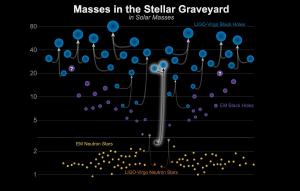Blog
The Dark Edge
24 June 2020
 LIGO-Virgo/ Frank Elavsky & Aaron Geller (Northwestern)
LIGO-Virgo/ Frank Elavsky & Aaron Geller (Northwestern)Black holes are the ultimate limit of gravitational collapse. Bring enough mass into a small enough volume, and its own weight will squeeze the mass into oblivion. All that remains is a warped pocket of space that it can trap anything that strays too close, even light.
In principle, there is no minimum amount of mass needed. If you can squeeze a chunk of matter hard enough, it will eventually reach a point of collapse. But things aren’t so simple in practice. When you squeeze matter, matter pushes back. The balance between the push of matter and the pull of gravity puts planets and small stars in a state of hydrostatic equilibrium. A star such as our Sun is too small to become a black hole, and will instead end its days as a white dwarf.
 Robin Dienel/The Carnegie Institution for Science
Robin Dienel/The Carnegie Institution for ScienceHowever hydrostatic equilibrium has its limit. There is a point where matter can no longer oppose the crushing force of gravity, and that limit seems to be a bit more than 2 solar masses. The internal fusion of matter in a star’s core can keep larger stars from collapsing for a time, but when the fusion stops it becomes a hydrostatic battle between matter and gravity. Any star smaller than 1.4 solar masses collapses into a white dwarf, and anything larger collapses into a neutron star, up to the Tolman–Oppenheimer–Volkoff (TOV) limit for neutron stars. Larger than that, and the star collapses into a black hole.
The most accurate calculations of the TOV limit put the maximum mass of a neutron star at about 2.16 solar masses. The most massive confirmed neutron star has an estimated mass of 2.14 solar masses. In 2017, LIGO observed the merger of two neutron stars, from which astronomers determined the limit is about 2.2 solar masses.1 On the other hand, the smallest observed black hole could have a mass of about 3.7 solar masses, though some estimates put its mass closer to 5. In between these two lies what astronomers call the mass gap. Somewhere within this gap is the dark edge between neutron stars and black holes.
 LIGO/Caltech/MIT/R. Hurt (IPAC)
LIGO/Caltech/MIT/R. Hurt (IPAC)Now LIGO has discovered an object right on the edge.2 In August of 2019, they observed gravitational waves from the merger of a 23 solar mass black hole with an object 2.6 times the mass of the Sun. With that mass, it is either the smallest black hole discovered or the largest neutron star. If it is a neutron star, then our traditional model of neutron stars must be somewhat wrong. It might be a more exotic object known as a quark star.
Unfortunately, while the mass of the object is well defined, there is no way to tell its nature. In theory, the merger of a black hole with a neutron star or quark star would produce an x-ray burst in addition to gravitational waves. But this merger was so distant it would be difficult to detect a light signal, and no corresponding light signal has been seen.
Still, we now know some objects are very close to black hole limit. With more observations, we will soon know what that limit truly is.